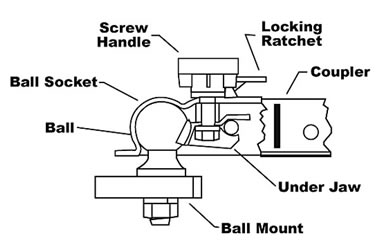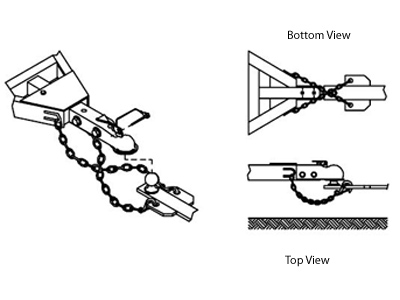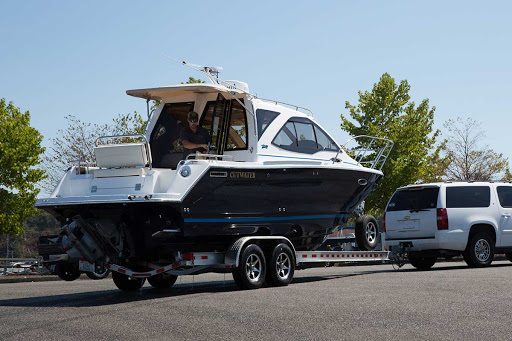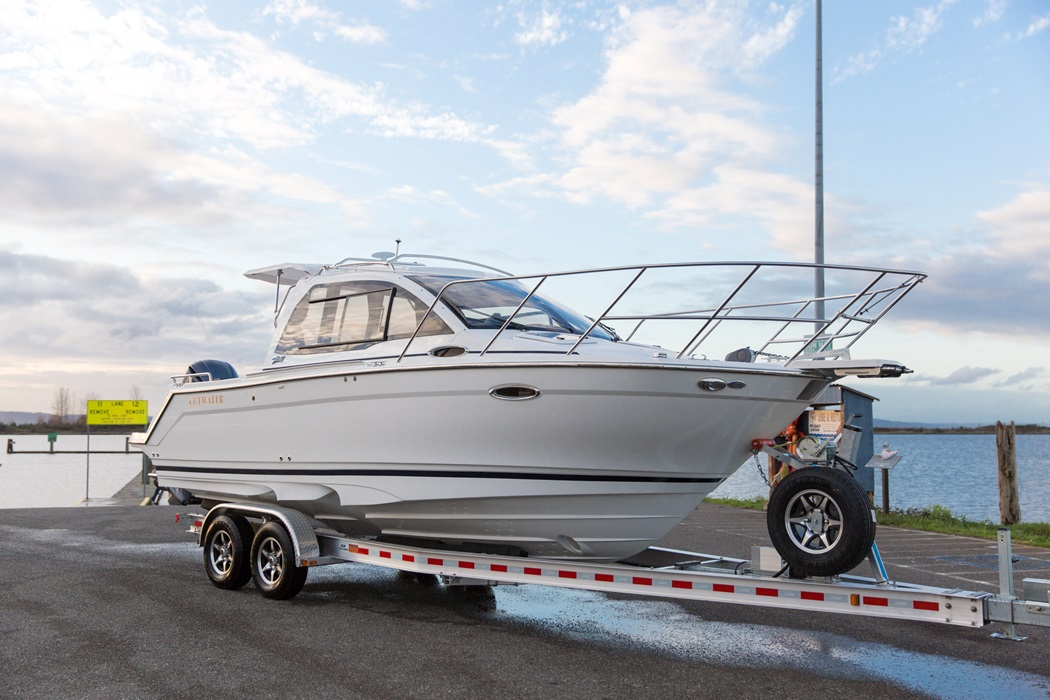In the Pacific Northwest, heading east can provide some of the best lake boating around. Destinations like Lake Chelan, Lake Billy Chinook, Lake Wenatchee, and Lake Crescent can provide great weekend getaways for fishing, water skiing and camping. For boaters in the Northern regions of the Northwest, towing a boat to the Columbia River can be an alternative to the Inside Passage or San Juan Islands. In reverse, Columbia River boaters can easily tow a bow to Olympia and the Puget Sound for the summer, a vacation, or even a long weekend.
Boat ramps pepper these regions making access to new waters really easy. Many are located within campgrounds for a late-night arrival and offer staging docks to make loading up easier. There are usually small towns with grocery stores and fuel stations close by to stock up before hitting the water. Some areas have marinas with guest docks, power and pump-out stations.
Experience the freedom of exploring a wider range of lakes, rivers, bays and sounds by towing your boat to someplace new. Or, rather than motoring your boat to a favorite spot in the Puget Sound, why not tow it and start the trip sooner? Towing your boat can make staring a new adventure hours—not days.
What You Should Know
The popularity of moderate sized, outboard boats has made trailering much easier. Boat manufacturers and dealers have paired specific models with trailers for a safe way to haul your boat up and down the highway. If your boat didn’t come with a trailer, there are many local trailer manufacturer that build adjustable trailers that can be fit to your boat and possibly your next boat. With the right trailer and tow-vehicle anyone can safely haul their boat. However, there are some key considerations in preparation to making that first trip.
Pick the right tow vehicle for the job.
- Not all SUVs and pickups are capable of towing all boats. Depending on the boat, your current vehicle may be a great towing machine. Check the owner’s manual for towing capacities then compare it to the weight of your boat, trailer and all of the gear aboard. Confirm the receiver (if installed) meets the weight requirements and that the tires installed are rated for towing or designed for trucks—not passenger vehicles or light truck use. It is important to note fuel, water, and waste can have a significant effect on the overall weight; make sure these details are added to your calculation.
- If your vehicle is not up to the task, it’s time to go shopping. When looking for a tow vehicle there will be some decisions to make. Put together a list of wants and needs before heading out to the dealer or online. Are you hauling the family? Then a 4-door pickup or heavy-duty SUV may be the right choice. Hauling your boat over mountain passes to access lakes and rivers? A diesel engine’s low-end torque will help tackle the mountains with ease. The key element in your decision should be to match the rig with what you expect to tow. Factory installed towing packages will reduce the wear on the vehicle by including transmission coolers, lower geared axles, heavy duty brakes, and in some cases include dashboard control of electronic trailer braking systems. Some feature a back up system that does the steering for you. Most times, the factory installed towing package will cost less than adding all of the components separately.
- Modern amenities in vehicles manufactured after 2010 make trailering easier. Back-up cameras simplify connecting a trailer—turning it into a one-man job. Rotating and extendin mirrors give drivers better visibility around wider boats but can be tucked in for everyday use. Hill holding features will prevent the tow vehicle from rolling backward on launch ramps when making the transition from brake to accelerator.
Trailer Hitches
- Although it was mentioned above, it is important to discuss trailer hitches in a little more detail. Receiver hitches are offered in several different classes—each class having a specific weight range. The class designation is usually stamped on the hitch with a weight range. Do not exceed the limits of the hitch; a failure will likely cause damage to your boat, trailer and vehicle and puts others on the roads at risk. Receiver hitches require a hitch ball mount or stinger to attach the trailer ball. They are available in various configurations to compensate for differences in height between the tow vehicle and the level trailer. Some are adjustable to fine-tune different loads/trailers. Others will provide several balls to match a range of trailers. Trailer hitch balls come sized to match the trailer. The proper ball size is usually stamped on the trailer coupler at the tongue.
Connecting the trailer
- In connecting the trailer to the hitch, the goal is to back the vehicle to perfectly align the hitch ball with the coupler—a 1⁄2” off can prevent the trailer from “dropping” onto the ball. If you have the convenience of a backup camera it will be like a video game. If your vehicle doesn’t have a backup camera, don’t worry. Another person to spot you as you back will work, or magnetic poles can be mounted on the trailer and ball to offer reference guides as you back up. Once you have the ball and coupler close you can lower the trailer onto the ball. You may need to wiggle the trailer or hitch ball mount to get the coupler to drop onto the ball. In some cases, you may have to move the vehicle to achieve the proper alignment.

- The trailer tongue has a mechanism that locks onto the trailer ball: the under jaw. It normally locks onto the trailer ball will little effort and shouldn’t require any tools: i.e. a hammer. If you have trouble locking the trailer onto the hitch, make sure that the tongue is completely on the ball. If the under jaw is not fully open when the tongue is lowered onto the ball it can jam preventing total engagement. When this happens—and it will—just pry open the under jaw with stick or hammer handle.
- Most states require safety chains in the event the trailer separates from the hitch. It is important that there are in good working order: not corroded to the point of failure. Cross the chains under the trailer tongue or coupler so that if the trailer separates, it falls into the chains and is held off the pavement.

- A wiring harness on the vehicle side (usually part of the tow package) features a quick connector to operate the trailer lights in unison with the vehicle lighting. These connectors can be mounted to the bumper or hitch or they can be supported by cable ties. There are multiple configurations. Don’t worry if the one on your trailer is different from the one on the truck. There are several adaptors to make the connection. Once connected, it is important to check the light—all the lights. Have a buddy confirm that the blinkers, running lights and most importantly the brakes lights are functioning properly. You can also use the reflection off the garage door if your buddy has skipped out on you. If your trailer is equipped with electronic brakes, check to confirm their operation in the parking lot or local streets before hitting the highway or busier expressways. When connecting the wiring harness, make sure it is clear of the safety chains and any other part of the trailer that can rub and compromise the wire insulation.
Driving Forward
- Sitting in the driver’s seat your SUV or Truck will feel the same, but remember that with a trailer it is often more than twice its normal length. Driving through the grocery store parking lot or the gas station will take a little extra thought. Take turns a little wider to allow the trailer to clear the curb, posts, parking barriers etc. You can set up turns by hugging the outside of the lane and aiming for the outside of the lane you’re turning into to allow the trailer to take the widest possible path. This is not a foolproof rule, there will situations that the overall length of your boat and truck won’t make the turn—looping around the block or finding an alternative route is often the work-around. Get a feel for what turns you can make and avoid tighter turns that you may have to back out of.
- Not only are you longer on the road with a trailer, you are also heavier. This means accelerating is slower and stopping takes longer. With a trailer in tow, driving will “feel” heavier; turns will feel different and braking will feel different. Hang back from the traffic to allow for extra stopping distance and keep an eye out and anticipate potential hazards—merging or turning or merging vehicles, stopped traffic, potholes, curbs, etc. If you ride a motorcycle, apply some of the same safety techniques.
- The boat and trailer are likely to be wider than the tow vehicle. Aim rearview mirrors so that you can see trailer wheels in relationship to lines on the road. This will help you center yourself in the lane and will help in backing up.

Backing Up
- Driving backward is the most dreaded task of trailering—especially if you have the pressure and audience of a crowded launch ramp. First thing to realize is that NO trailer will backup perfectly straight. It doesn’t matter how long you’ve been doing it, a minute change in direction of the truck will result in a dramatic change in the trailer direction. What the seasoned drivers at the ramp they are constantly adjusting to position the trailer where they want it. The other thing to remember is that not all trailers behave in the same way. Double and triple axles trailers typically track a little straighter, but they struggle a little to make tight turns. The distance between the coupler and the axles plays a role in how the trailer handles backing up. Typically, the longer the distance between the coupler and axles, the less sensitive the trailer is to steering adjustments.
- Backing up is not a race. Take your time. The trailer direction can change quickly especially shorter trailers. Find an empty parking lot and use some beater lifejackets or cones as markers and practice. The trailer will go in the opposite direction the steering wheel is turned. An easy trick when first starting out is to grasp the bottom of the steering wheel (6 0’clock)—the trailer will turn in the direction you move your hand. Once the turn is initiated, you can begin to turn the steering wheel in the opposite direction to “follow” the trailer and maintain the arc of the turn. Take a methodical approach, minor turns with the tow vehicle are multiplied when backing up and can change trailer direction dramatically.
- Always accept help from a spotter. They can see the blind side of the trailer and prevent you from accidentally running the boat, motor, or trailer into a barrier.
- Use your mirrors. The boat will prevent you from seeing directly behind you, the wider mirrors on many tow vehicles are your best friend for backing up. Find stationary references (curbs and striping) to gauge alignment and changes in direction.
On the highway
- The extra weight of a boat and trailer will reduce your ability to accelerate. Allow for extra space and time to get into traffic or pass other vehicles.
- Slow down. Your SUV or pickup was engineered for highway speeds without a 10,000 lb. boat behind it. Think of it like having another (only bigger) SUV or pickup tail-gating you. Many states post a separate speed limit for vehicles with a trailer in tow; It may be a little slower, but it’s still worlds faster than making the journey by water.
- Leave extra space between other vehicles; remember your stopping distance will be increased by the extra weight.
- Large trucks and buses will effect you and your boat. The wind wake from a tractor- trailer or a large bus will push you and your boat around a little. The best proactive move is to let off the accelerator when you notice a larger vehicle is about to pass you. When passing a Semi, move over and provide as much space between you and the truck as is practical—and safe.
- Use blinkers to warn others of your intentions. Your limited abilities to see behind you can be a challenge. By letting other drivers know your intentions you may find they provide some extra space when merging or flash their lights when it is safe to merge right after passing. Note: not everyone is as polite as Pacific Northwesterners, local driving habits and attitudes may come into play.

Troubleshooting
- At every stop (even after just a mile or two down the road) check the bearings—they should be cool enough to touch. Your trailer is repeatedly dunked in the water and the bearings are exposed to fresh or saltwater. For this reason, they are the biggest maintenance item on the trailer. Their failure can send a wheel down the road and make for an unstable load. Special hub-caps with a spring-loaded reservoir and grease fitting are a way to make maintenance easier.
- Trailer instability (wagging) can be indicative of too little tongue weight. As mentioned above, fuel and water weight can have dramatic effects on weight distribution. Gasoline weighs about 6 lbs./gallon and water is 8 lbs./gallon. A few hundred gallons of each can add up quickly. Often tanks are located in the aft of the boat. This can reduce tongue weight and have adverse effect on tracking. If you sense that the trailer is “wagging” behind your vehicle it could mean that there is too little tongue weight. The goal is about 10%-15% of the gross weight of the boat and trailer. Keep in mind that each class trailer hitch has a maximum safe tongue weight. The boat position in relationship to the axles fine tunes tongue weight. But is not something that can be done on the fly. Best practices say to travel with empty tanks; this will increase your gas mileage and the wear and tear on the trailer and tow vehicle.
- Vehicle instability. Too much tongue weight can lighten the front end of the tow vehicle and adversely effect the steering and braking. It can also cause unwanted wear on the suspension and brakes.
- Lights malfunctioning. Wiring harness are vulnerable. Like the wheel bearings they live a harsh live of being submerged on a regular basis. Corrosion will play the biggest role in malfunctions followed closely by abraded or cut wires. Look at the quick connectors for discoloration or obvious corrosion. Some emery cloth or even a pencil eraser can remove minor corrosion. Next check the wiring harness; first looking at known wear points then along the wires where they may have been pinched or abraded by straps, clamps, etc.